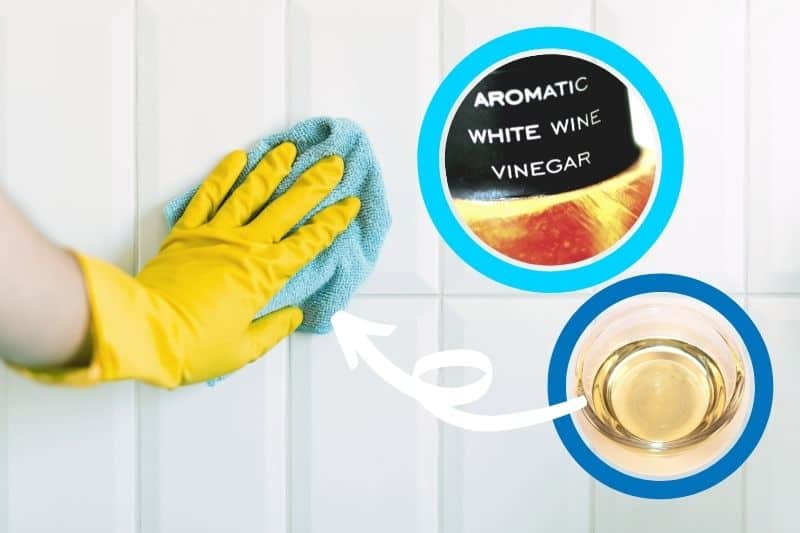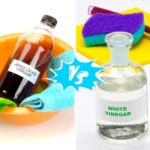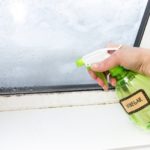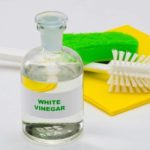If you’ve run out of your everyday cleaning goodies, but you’ve got half a bottle of white wine vinegar in the cupboard, you might be wondering if you can use this vinegar to clean stuff around the house.
The answer is yes!
White wine vinegar is great at cleaning things around the home. However, it is more expensive than simple white vinegar (which can also be used for a multitude of cleaning tasks) so only use white wine vinegar if you’re using up a bottle you already have.
Let me tell you more about white wine vinegar.
White Wine Vinegar Uses
Like its other family members, white wine vinegar has lots and lots of uses. There are literally so many uses that I won’t be able to list them all for you. So, I’ve picked my favourite ones to share with you…
1. Windows
If you’re looking for a really cheap way of making your windows sparkle, look no further than white wine vinegar. This handy household good has just the right amount of acidity to remove grime off window panes, plus it’s got a rather nice smell.
What you need:
- Half a cup of white wine vinegar
- A litre of warm water
- Bucket/spray bottle
- Cotton cloth
- Scrunched up newspaper
What you need to do:
- Grab a normal-sized bucket. (see below for spray bottle method)
- Pour a litre of warm water into the bucket.
- Add half a cup of white wine vinegar to the bucket.
- Swish the mix around in the bucket.
- Pop a cotton cloth into the water and allow it to be saturated by the water.
- Squeeze out the excess water.
- Start rubbing at the windows with the damp cotton cloth.
- Allow the windows to dry – air will dry them, so open a window.
- Grab your scrunched up newspaper and start buffing the windows with it.
If you plan on using a spray bottle instead of a bucket, pop one part of white wine vinegar into three parts of warm water into the spray bottle and shake it. Spray this mix onto the window, then use a cotton cloth to wipe the product off the panes.
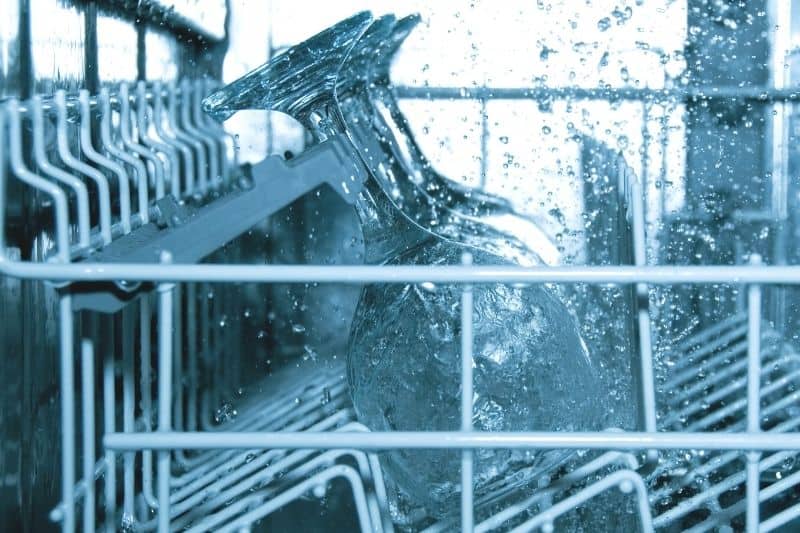
2. Dishwashers
If you fancy giving your dishwasher a quick refresh you can use white wine vinegar. This will also help to unclog the dishwasher too, because it can break through grease, as well as general dirt.
What you need:
- Two bowls
- White wine vinegar
What you need to do:
- Fill two dishwasher safe bowls up with white wine vinegar.
- Pop one bowl in the top rack of your dishwasher.
- Pop the second bowl on the bottom rack of your dishwasher.
- Start a long and hot cycle.
- The white wine vinegar will be swirled around the dishwasher as it completes its cycle.
- You can run an additional empty hot cycle, without vinegar, afterwards if you like.
3. Limescale
Any items in the home that are exposed to water, particularly hard water, might be riddled with limescale. These items include taps, showerheads and toilets. But they can all be cleaned really easily with white wine vinegar!
If you want to clean taps, all you need to do is pop one part of white wine vinegar into three parts of warm water into a spray bottle, shake it and spray it onto the taps. Wipe down the taps, so you soak up the mixture.
If you want to clean a showerhead, you can leave it to soak in a bag filled with white wine vinegar for a few hours. Run the hot water to clean off any vinegar before you use the shower, and don’t forget to wipe the back of the showerhead down too.
If you’d like to remove limescale from your toilet, all you need to do is add about a litre or so of white wine vinegar to the toilet pan. Make sure you coat the inside sides of the toilet with vinegar too.
Then you need to leave the toilet for about 4 hours. When you return, you’ll have to scrub the sides and rim of the toilet, and then you can flush the toilet.
4. Towels
If you’ve got tired towels sitting in your airing cupboard, you need to give them some TLC to freshen and soften them up. All you need to do is use white wine vinegar.
What you need:
- Half a cup of white wine vinegar
- Towels
- Washing machine
What you need to do:
- Add half a cup of white wine vinegar to your detergent drawer.
- Select a warm, or normal cycle.
- Stick your towels in the washing machine.
- Run the cycle.
- There is no need to use detergent, but if you want to run a further cycle with detergent this can be done later on.
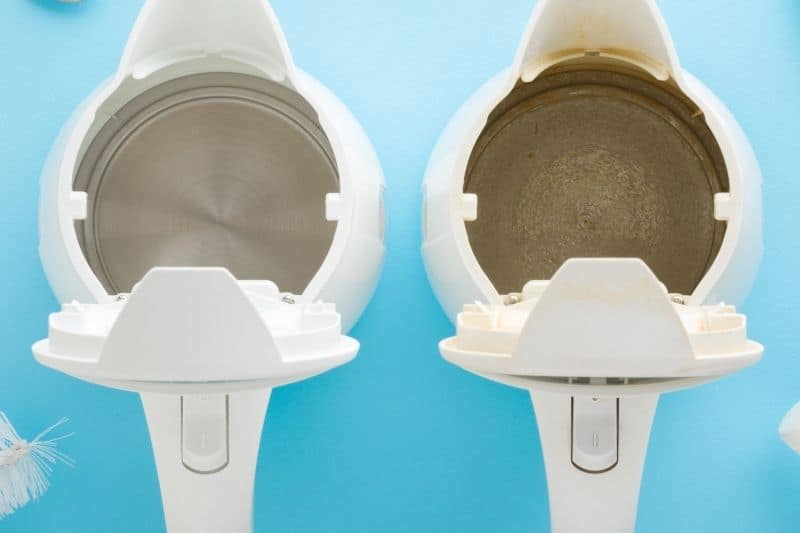
5. Descaling Kettles
While we enjoy our cups of tea and mugs of coffee every single day, our faithful little kettle is being plagued by limescale. This unwelcome guest usually goes unnoticed for a few months, and in some cases, people don’t even know that it can get into a kettle.
But keeping limescale at bay isn’t really that difficult, all you need is some white wine vinegar.
What you need:
- Kettle
- Water
- White wine vinegar
What you need to do:
- Fill half your kettle up with white wine vinegar.
- Fill the other half of your kettle up with water.
- Allow the two ingredients to sit like this together for around half an hour.
- When the time has passed, boil the kettle.
- Wait a few minutes before you empty the contents of the kettle.
- Empty the kettle.
- Rinse the kettle out with some more tap water.
If you like you can do this every month, or every couple of months. It’ll help to keep the kettle clean and in working order.
Bonus tip: Don’t overfill your kettle up when making a cuppa because heating the additional water takes more energy, time and costs more. But also, this extra water just sits at the bottom of the kettle and becomes stagnant.
6. Carpet Stains
If you’ve got a stain on your carpet, you need to act as fast as possible to remove the stain. The best way to do this is to use a product that you already have in the house to clear up the mess.
One item a lot of us have in our cupboards is white wine vinegar, and it just so happens it’s pretty effective at removing carpet stains.
What you need:
- White wine vinegar
- Cotton cloths
- Warm water
- Spray bottle
- Washing up liquid
What you need to do:
- Fill half a spray bottle with white wine vinegar.
- Fill the rest of the bottle with warm water.
- Shake the bottle.
- Test the mixture on a concealed piece of carpet first.
- If it’s okay, move on.
- Spray the mixture evenly over the stained area.
- Leave the carpet for 5 minutes, or so.
- Grab your cotton cloth.
- Start dabbing at the stained area – no scrubbing.
- Repeated this process, if need be.
- Dab a new wet cotton cloth in a tiny amount of washing up liquid.
- Press this washing up liquid into the stain.
- Blot the area with a cotton cloth to soak up any excess fluid.
- Air-dry the area.
Keeping a window or door open will help to dry the carpet a lot faster. And try not to walk over the carpet while it’s drying.
7. Deodorising the Microwave
If you’ve got a stinky microwave, you can clear away the smell by using white wine vinegar.
What you need:
- White wine vinegar
- Bowl (microwave safe)
- Water
What you need to do:
- Put half a cup of white wine vinegar into a bowl.
- Add a cupful of warm water to the bowl.
- Place the bowl in the centre of the microwave.
- Set the microwave up to cook for 5 minutes.
- Leave the bowl in the microwave for another couple of minutes once the timer has gone off.
- Use oven mitts to remove the bowl from the microwave.
- Grab a cotton cloth and wipe down the insides of the microwave.
The heat, combined with the fruity scent of the vinegar, will give your microwave a lovely fresh smell.
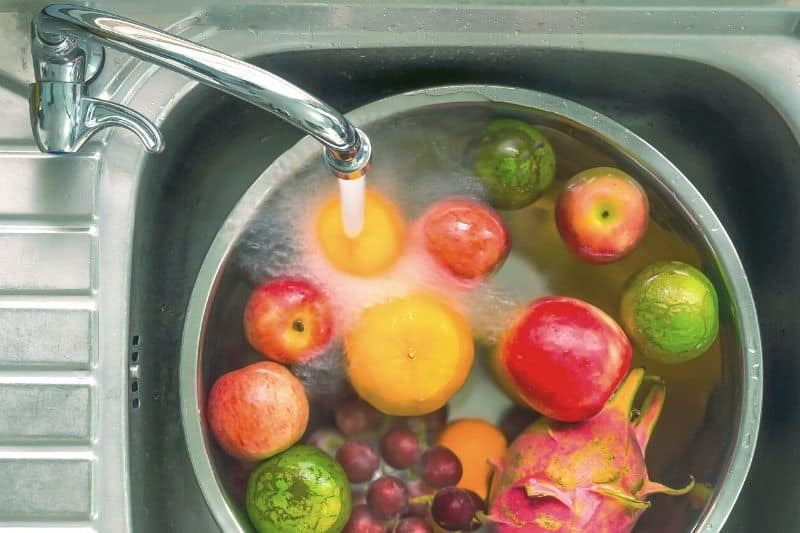
8. Washing Vegetables and Fruit
White wine vinegar can help to remove bacteria from fruit and vegetables that we buy from shops and markets.
What you need:
- Spray bottle
- White wine vinegar
- Water
What you need to do:
- Put one part of white wine vinegar into the spray bottle.
- Put three parts of cold water into the spray bottle.
- Shake the bottle.
- Spray the vegetables and fruit.
- Always wash the vegetables and fruit again in water before you cook or eat them.
Don’t Use White Wine Vinegar on…
Although vinegar can be used in loads of areas around your home, there are certain places where you shouldn’t use any kind of vinegar, this includes the fragrant white wine vinegar.
These places include…
- Granite worktops.
- Marble worktops or floors.
- When trying to remove an egg stain don’t use vinegar because it’ll make your cleaning even harder.
- Irons shouldn’t be cleaned with vinegar.
Should you wish to clean the surfaces and/or appliances mentioned above, you should check your user manual to see what it says about maintenance or look into creating/buying a specialised cleaning product.
Conclusion
White wine vinegar can be used for cleaning. In fact, it has many cleaning uses around the home.
However, if you have the option of buying a different type of vinegar, go with white vinegar because it’s the better cleaning product of the two. Mainly because it’s stronger!
FAQs
What is white wine vinegar?
White wine vinegar is a product that has been produced through a process called fermentation. During this fermentation process, white wine, which is the core ingredient of white wine vinegar, gets put into a large vat. Then the alcohol in the wine gets exposed to huge quantities of oxygen.
By the end of this process, you end up with something called acetic acid. A lot of water then gets added to this acetic acid, and in a nutshell, you have white wine vinegar.
White wine vinegar typically has a lovely fruity smell, which is probably caused by the wine that it came from. And it’s sometimes a little cloudy in colour.

Bethan has a passion for exploring, reading, cooking and gardening! When she’s not creating culinary delights for her family, she’s concocting potions to keep her house clean!
